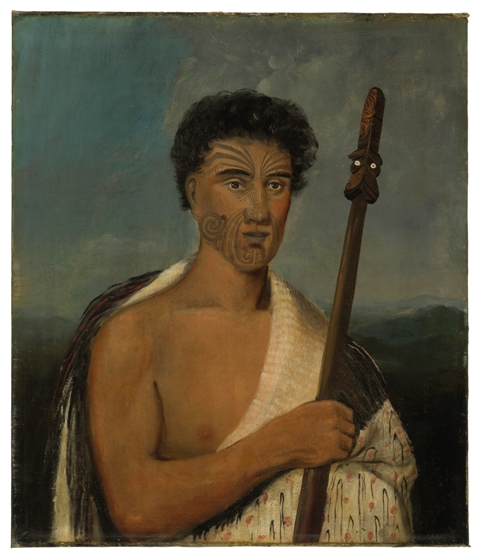
Though Duke is largely known for the whaling images, the focus was on the acquisition by the NGA of the portrait of Maori chief Hohepa Te Umuroa, 1846.
Te Umuroa played an important role in the attempts to negotiate a treaty with white settlers over land ownership in NZ. He learnt to speak English and was baptised a Christian, taking the name Joseph (Hohepa). Later sentenced to be transported toTasmania, he died in custody tuberculosis in 1847. His remains were exhumed and repatriated toNew Zealandin 1988.
The artist shows the 26-year-old Hohepa Te Umuroa in a stylised pose holding his sacred tokotoko, his symbol of authority and status, and dressed in a traditional Maori cloak.
“The painting of Te Umuroa by William Duke is one of the earliest known oil portraits of an individual Maori and provides an important record of a dark chapter in our colonial past”, Radford said.
The artist William Duke was born inIrelandin 1814 and arrived in NSW in 1840 as an assisted immigrant. He worked briefly in Sydney as a scene painter and mechanist at the Royal Victoria Theatre before moving briefly to NZ in 1844. He moved to Hobart in May 1845, where he remained for seven years, before moving to Victoria.
Duke is largely known for the whaling images that he produced during his stay in Tasmania and four of his lithographs will be displayed alongside the Hohepa Te Umuroa portrait at the National Gallery.
Following the gold rush, Duke moved to Victoria and continued to paint portraits and landscapes and worked as a scene painter.
“I am honoured that this striking portrait of Te Umuroa, painted by my esteemed great great grandfather, now has a place in the national collection,” Mr Bryce said. “The painting symbolises strength and courage during a period of great upheaval and serves as a reminder to us and future generations of the shared history between Australia and NZ.”
The life of Hohepa Te Umuroa has been the subject of a novel, “The Trowenna Sea” by Witi Ihimaera as well as an opera, “Hohepa,” premiering this month as part of the NZ International Arts Festival.
Who can be trusted?
In a world of spin and confusion, there’s never been a more important time to support independent journalism in Canberra.
If you trust our work online and want to enforce the power of independent voices, I invite you to make a small contribution.
Every dollar of support is invested back into our journalism to help keep citynews.com.au strong and free.
Thank you,
Ian Meikle, editor








Leave a Reply